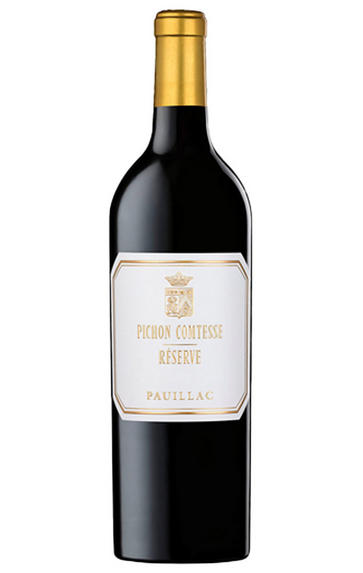
2021 Pichon Comtesse Réserve, Pauillac, Bordeaux
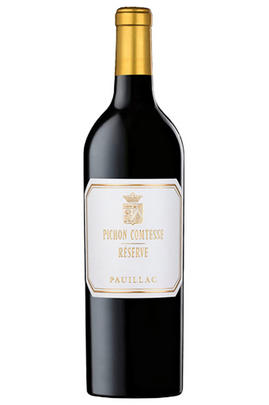
Critics reviews
The 2021 Réserve de la Comtesse has a pretty bouquet, not intense but well-defined, featuring blackberry, cedar and light graphite aromas. The palate is medium-bodied and quite saline in the mouth, with grippy tannins, good body and just a slight austerity on the finish. Not bad at all, though there is a considerable gap between this and the Grand Vin this year. Give it three to four years in bottle.
Drink 2025 - 2038
Neal Martin, vinous.com, (May 2022)
The 2021 Réserve de la Comtesse is a seriously great wine in its peer group. Or any peer group. Rich and layered, with no hard edges and compelling balance, the 2021 opens beautifully in the glass. Savory accents run through a core of black cherry and plum fruit, with hints of gravel, spice and leather that develop later. This year's blend includes 14% reserve wine, but that is not especially evident. I don't think I have ever tasted a more refined Réserve de la Comtesse. Superb.
Drink 2026 - 2036
Antonio Galloni, vinous.com (May 2022)
Savoury blue fruit, nice balance, concentrated through the mid palate, soft tannins that have been carefully handled to emphase the fruit. 14% press wine. 15hl/h yield (after the Merlot in particular was impacted by mildew and unevent fruit set). First year of organic conversion. 40% of overall production in this, 50% new oak for ageing.
Drink 2025 - 2036
Jane Anson, janeanson.com (May 2022)
The 2021 Resèrve de la Comtesse offers up aromas of sweet berry fruit, blackcurrants, petals and classy new oak, followed by a medium to full-bodied, deep and impressively concentrated palate that's framed by lively acids and beautifully refined tannins. It's a blend of 56% Cabernet Sauvignon, 36% Merlot and 11% Petit Verdot, and Nicolas Glumineau tells me that some wine was sold off in bulk this year to guarantee the quality of the Resèreve. It's certainly among the best second wines of the vintage.
William Kelley, Wine Advocate (Apr 2022)
A tight, focused red with currants, chocolate, walnuts and some flowers. Medium-to full-bodied with ripe tannins. Pretty second wine.
James Suckling, jamessuckling.com (May 2022)
About this WINE
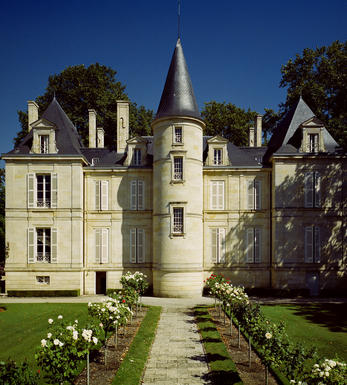
Château Pichon Comtesse
Château Pichon Comtesse is an estate in Pauillac on the Left Bank of Bordeaux. The estate was ranked a Second Growth in Bordeaux’s 1855 classification, and belongs to an unofficial group referred to as “Super Seconds”.
It is located in the southern part of the Pauillac appellation, just next to Château Latour and a short distance from the border with St Julien. The attractive château building here is visible from the D2 road as you approach Pauillac from the south, on the opposite side of the street from Château Pichon Baron. The two neighbours were once part of one larger estate, which was divided in two in 1850. From 1978 until the mid-2000s, Pichon Comtesse was managed by Madame May-Eliane de Lencquesaing, one of the most prominent women in Bordeaux history.
Today, the estate belongs to the Rouzaud family, owners of Champagne Louis Roederer. The estate, which currently has 80 hectares of vines, is managed by talented winemaker Nicolas Glumineau. Nicolas and his team also manage Château de Pez, a sibling estate further north in St Estèphe.
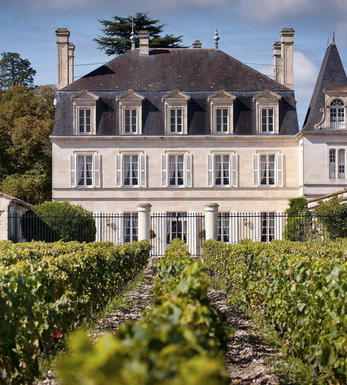
Pauillac
Pauillac is the aristocrat of the Médoc boasting boasting 75 percent of the region’s First Growths and with Grand Cru Classés representing 84 percent of Pauillac's production.
For a small town, surrounded by so many familiar and regal names, Pauillac imparts a slightly seedy impression. There are no grand hotels or restaurants – with the honourable exception of the establishments owned by Jean-Michel Cazes – rather a small port and yacht harbour, and a dominant petrochemical plant.
Yet outside the town, , there is arguably the greatest concentration of fabulous vineyards throughout all Bordeaux, including three of the five First Growths. Bordering St Estèphe to the north and St Julien to the south, Pauillac has fine, deep gravel soils with important iron and marl deposits, and a subtle, softly-rolling landscape, cut by a series of small streams running into the Gironde. The vineyards are located on two gravel-rich plateaux, one to the northwest of the town of Pauillac and the other to the south, with the vines reaching a greater depth than anywhere else in the Médoc.
Pauillac's first growths each have their own unique characteristics; Lafite Rothschild, tucked in the northern part of Pauillac on the St Estèphe border, produces Pauillac's most aromatically complex and subtly-flavoured wine. Mouton Rothschild's vineyards lie on a well-drained gravel ridge and - with its high percentage of Cabernet Sauvignon - can produce (in its best years) Pauillac's most decadently rich, fleshy and exotic wine.
Latour, arguably Bordeaux's most consistent First Growth, is located in southern Pauillac next to St Julien. Its soil is gravel-rich with superb drainage, and Latour's vines penetrate as far as five metres into the soil. It produces perhaps the most long-lived wines of the Médoc.
Recommended Châteaux
Ch. Lafite-Rothschild, Ch. Latour, Ch. Mouton-Rothschild, Ch. Pichon-Longueville Baron, Ch. Pichon Longueville Comtesse de Lalande, Ch. Lynch-Bages, Ch. Grand-Puy-Lacoste, Ch, Pontet-Canet, Les Forts de Latour, Ch. Haut-Batailley, Ch. Batailley, Ch. Haut-Bages Libéral.
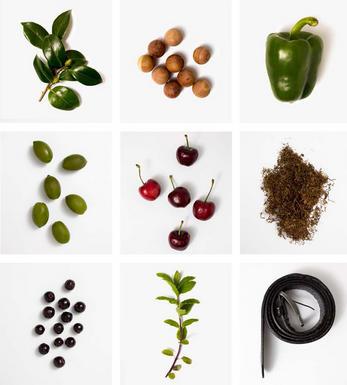
Cabernet Sauvignon Blend
Cabernet Sauvignon lends itself particularly well in blends with Merlot. This is actually the archetypal Bordeaux blend, though in different proportions in the sub-regions and sometimes topped up with Cabernet Franc, Malbec, and Petit Verdot.
In the Médoc and Graves the percentage of Cabernet Sauvignon in the blend can range from 95% (Mouton-Rothschild) to as low as 40%. It is particularly suited to the dry, warm, free- draining, gravel-rich soils and is responsible for the redolent cassis characteristics as well as the depth of colour, tannic structure and pronounced acidity of Médoc wines. However 100% Cabernet Sauvignon wines can be slightly hollow-tasting in the middle palate and Merlot with its generous, fleshy fruit flavours acts as a perfect foil by filling in this cavity.
In St-Emilion and Pomerol, the blends are Merlot dominated as Cabernet Sauvignon can struggle to ripen there - when it is included, it adds structure and body to the wine. Sassicaia is the most famous Bordeaux blend in Italy and has spawned many imitations, whereby the blend is now firmly established in the New World and particularly in California and Australia.


Buying options
Add to wishlist
Description
Cabernet Sauvignon 56%, Merlot 36%, Petit Verdot 8%
After the problems with mildew on the Merlot and Cabernet Sauvignon in 2021, all the Petit Verdot had to be used in this blend to cover the mid-palate dip left by Merlot. All things considered, this is a good effort. Nicolas Glumineau has not tried to make a silk purse from a sow’s ear. This is a different style and quality against the grand vin, but it does have a little of the silky finesse more usual here. This is a pleasing bottle and will be relatively early to mature. Drink 2024-2032.
Our score: 15.5/20
Berry Bros. & Rudd, April 2022
wine at a glance
Delivery and quality guarantee